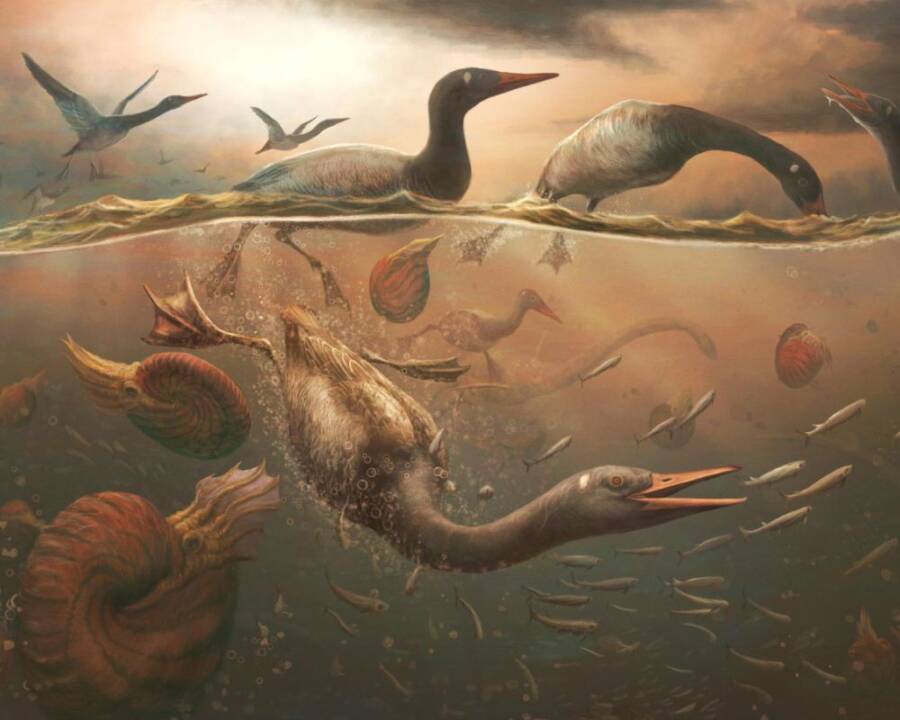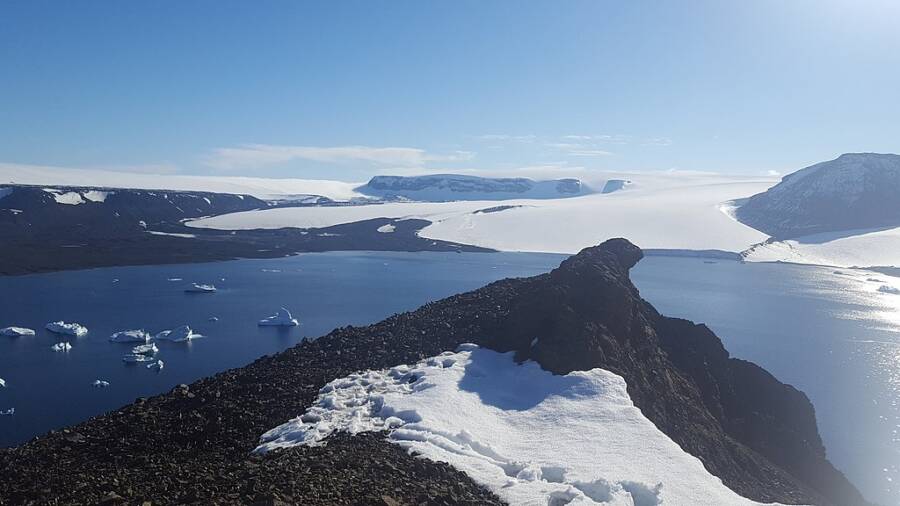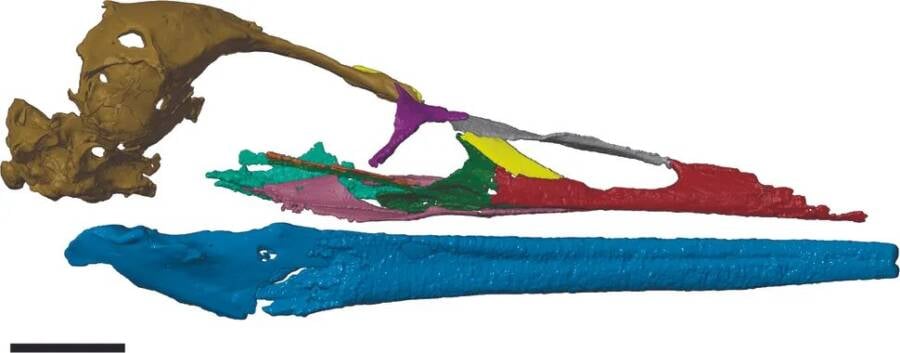The 69-million-year-old fossilized skull of Vegavis iaai unearthed in Antarctica suggests that modern birds evolved before the mass extinction event that killed the dinosaurs at the end of the Cretaceous Period.

Mark WittonAn illustration of Vegavis iaai, the duck-like creature that lived in Antarctica during the Cretaceous Period.
Long before Antarctica became the frozen desert we know it as today, it was the temperate, forested home of one of Earth’s earliest modern bird species: Vegavis iaai.
V. iaai thrived in Antarctic waters during the Cretaceous Period some 69 million years ago. Its incomplete fossils have puzzled scientists for decades, sparking debates about whether it was truly an early ancestor of today’s ducks and geese.
In 2011, researchers unearthed a skull from V. iaai, allowing them to analyze its features in full. Their recently published findings revealed that the species had a brain shape similar to modern birds, a distinct beak structure, and strong jaw muscles suited for underwater hunting.
Researchers are still piecing together the creature’s place in the evolutionary record, and they hope that future fossil discoveries will provide a clearer picture of how birds survived the mass extinction event that spelled the end for most dinosaurs.
Finding Fossils Of ‘Vegavis Iaai’ In Antarctica
In 1992, the first Vegavis iaai fossil was discovered on Vega Island in Antarctica. It dated back roughly 68 million years to the Cretaceous Period, a geological era that saw some of today’s most recognizable dinosaurs, including the Tyrannosaurus rex and Triceratops. During this period, Antarctica was a lush rainforest with average temperatures hovering at 66 degrees in the summer.
The end of the Cretaceous Period came when a giant asteroid struck Earth, causing the extinction of non-avian dinosaurs. Many scholars assumed that modern birds evolved in response to this mass extinction event, but the discovery of V. iaai has turned that idea on its head.

Joseph W. Holliday/Wikimedia CommonsVega Island in Antarctica, where the first V. iaai fossil was discovered.
“We have long recognized that modern birds exploded in diversity in the immediate wake of the end-Cretaceous mass extinction. But what were modern birds up to just before that extinction event? Most modern phylogenomic studies agree that many…divergences among modern birds must have arisen prior the end-Cretaceous mass extinction event,” study co-author Christopher Torres, a paleontologist at The University of the Pacific in Stockton, California, told All That’s Interesting. “But fossils that record that interval of bird evolution are vanishingly scarce.”
Julia Clarke, a paleontologist at the University of Texas, Austin, was the first to describe V. iaai as an ancestor of modern birds, particularly waterfowl. Other scholars doubted the finding, citing the 1992 fossil’s lack of a skull.
“[The initial fossil] was just a completely different part of the skeleton. And when it comes to birds, the skull has a lot of phylogenetic or informative characteristics that tell you what it is,” study co-author Patrick O’Connor, an evolutionary biologist at Ohio University, told Live Science.
Then, in 2011, a fossilized skull of V. iaai was discovered, providing researchers the opportunity to better place the bird in the evolutionary record.
Analyzing The Oldest Modern Bird Fossil Ever Discovered
In a study recently published in the journal Nature, researchers examined the skull of V. iaai to learn more about the prehistoric species and its place in the bird family.
Using 3D reconstruction, researchers identified several key features of the bird. First, they discovered that it had a brain shape and beak structure typical of modern birds. The rock the skull was encased in was between 68.4 and 69.2 million years old, suggesting modern birds evolved before dinosaurs went extinct.
“[The skull] provides anatomical details that indicate Vegavis had jaws that were specialized to snapping up fish as it dove underwater – that’s an ecology quite unlike what we see in modern ducks and geese today and is instead much more similar to grebes and loons!” Torres explained to All That’s Interesting.

Joseph Groenke/Ohio University and Christopher Torres/University of the PacificA digital reconstruction of the skull of Vegavis iaai.
The analysis also showed that V. iaai had strong jaw muscles similar to today’s diving birds. This evidence supports a connection between V. iaai and modern birds, but it has not positively identified the species as an ancestor of ducks and geese.
“Vegavis was quite distant to ducks in terms of time, but it was a very close relative of ducks in terms of phylogeny – it was more closely related to ducks and geese than the extant screamers, some strange waterfowl from South America,” Torres stated.
Torres shared that the closest relative of V. iaai was another waterfowl called Conflicto. Its fossils were discovered on Seymour Island, just south of Vega Island.
“Vegavis is…from the same rock formation, but on the opposite side of the mass extinction event – Vegavis lived just prior, Conflicto lived just after,” he wrote. Unlike V. iaai, Conflicto was a long-legged wader bird. The differences between the species has intrigued Torres and his colleagues who are trying to understand how species adapt during mass extinction events:
“Further study of the Antarctic fossil record will likely help us understand how extant lineages of birds and other organisms responded to catastrophic global climate change in the past, and hopefully we will be able to use that understanding to predict how those same lineages might respond to such climate change in the (potentially very near) future!”
After reading about Vegavis iaai, the oldest modern bird, learn about mega penguins, the giant prehistoric birds that would have towered over modern humans. Then, discover 11 of Earth’s most incredible prehistoric animals.





